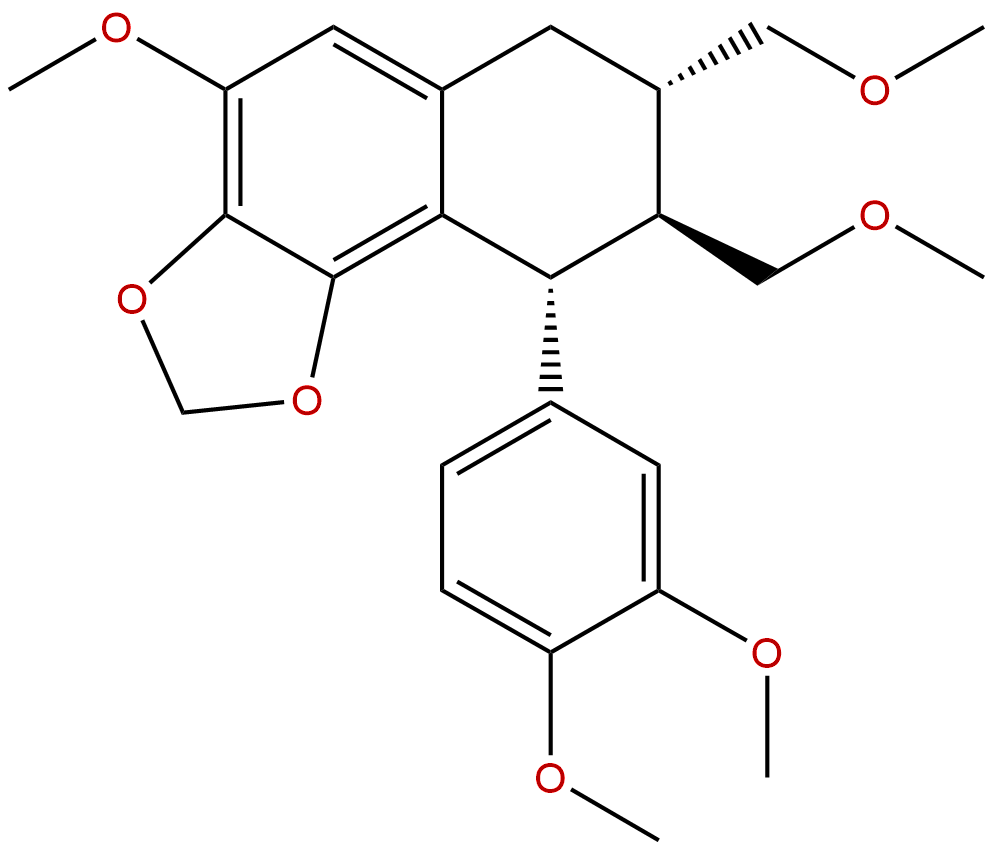
HypophyllanthinCAS No.:33676-00-5
|
||||||||||
 |
|
|
||||||||

| Catalogue No.: | BP0756 |
| Formula: | C24H30O7 |
| Mol Weight: | 430.497 |
Synonym name:
Catalogue No.: BP0756
Cas No.: 33676-00-5
Formula: C24H30O7
Mol Weight: 430.497
Botanical Source: Phyllanthus niruri, Phyllanthus amarus and Phyllanthus urinaria
Purity: 95%~99%
Analysis Method: HPLC-DAD or/and HPLC-ELSD
Identification Method: Mass, NMR
Packing: Brown vial or HDPE plastic bottle
Can be supplied from milligrams to grams.
For Reference Standard and R&D, Not for Human Use Directly.
Inquire for bulk scale.
Description:
Hypophyllanthin and phyllanthin have antitumour effects against Ehrlich Ascites Carcinoma in mice. Hypophyllanthin can modulate the vascular tension via the endothelium-independent mechanisms, it can directly inhibit P-gp activity and does not interfere with MRP2 activity, it may reversibly inhibit P-gp function. Hypophyllanthin offers a promising means for treatment of chronic muscle pain. Hypophyllanthin also has estrogenic properties against carbofuran induced toxicity in female rats.
References:
J Pharm Pharmacol. 2013 Feb;65(2):292-9.
Phyllanthin and hypophyllanthin inhibit function of P-gp but not MRP2 in Caco-2 cells.
The purposes of this study were to investigate the inhibitory effects of two lignans, phyllanthin and Hypophyllanthin, on the function of P-glycoprotein (P-gp) and multidrug resistance protein 2 (MRP2), using the in-vitro model of Caco-2 cells. In addition, the effect of prolonged exposure to these two compounds on the expression of active P-gp was also determined.
METHODS AND RESULTS:
The activity of P-gp and MRP2 was determined in the uptake assays by monitoring the intracellular accumulation of their specific substrates (calcein acetoxymethyl ester and 5(6)-carboxy-2',7'-dichlorofluorescein diacetate, respectively) with fluorescence spectroscopy. Hypophyllanthin and phyllanthin inhibited P-gp function with comparable potencies, but neither compound affected MRP2 activity. When the lignans were washed out before addition of substrate, the inhibitory action of both compounds against P-gp function was lost. These results suggested the reversibility of the inhibition. Moreover, prolonged exposure of the Caco-2 cells to both lignans (up to 7 days) had no effect on P-gp function.
CONCLUSIONS:
Phyllanthin and Hypophyllanthin directly inhibited P-gp activity and did not interfere with MRP2 activity. It was likely that both phyllanthin and Hypophyllanthin could reversibly inhibit P-gp function.
Fitoterapia. 2011 Dec;82(8):1231-6.
Endothelium-independent effects of phyllanthin and hypophyllanthin on vascular tension.
The purpose of this study was to investigate the modulating effects of phyllanthin and Hypophyllanthin on vascular tension, using in the in vitro model of isolated rat aorta.
METHODS AND RESULTS:
Our results indicated that both phyllanthin and Hypophyllanthin significantly relaxed the sustained contraction induced by phenylephrine (PE) in a concentration-dependent manner. In addition, endothelial removal had no significant influence on the vasorelaxation responses of the aortic rings toward these two compounds. Furthermore, both compounds inhibited the contraction of aortic muscle provoked by either PE (1 μM) or KCl (40 mM) as well as the spontaneous contraction of the Ca²⁺-depleted muscle. In high K⁺-Ca²⁺ free solution, phyllanthin (100 μM), but not Hypophyllanthin, significantly inhibited the contractile responses upon cumulative addition of CaCl₂. Both compounds (100 μM) significantly inhibited PE-induced contraction in Ca²⁺-free condition, but could not affect caffeine-induced contraction.
CONCLUSIONS:
Taken together, phyllanthin and Hypophyllanthin could modulate the vascular tension via the endothelium-independent mechanisms. The modulating effects of both compounds were possibly involved with the blockade of Ca²⁺ entry into vascular smooth muscle cells and inhibition of PE-mediated Ca²⁺ release from sarcoplasmic reticulum.
Phytother Res. 2015 Aug;29(8):1202-10.
Pain Modulation by Lignans (Phyllanthin and Hypophyllanthin) and Tannin (Corilagin) Rich Extracts of Phyllanthus amarus in Carrageenan-induced Thermal and Mechanical Chronic Muscle Hyperalgesia.
The current study was aimed at evaluating the antihyperalgesic effects of lignans (phyllanthin and Hypophyllanthin) and tannin (corilagin) rich three standardized extracts of Phyllanthus amarus in a model of chronic musculoskeletal inflammatory pain.
METHODS AND RESULTS:
Three percent carrageenan injected in the gastrocnemius muscle produced hyperalgesia to mechanical and heat stimuli ipsilaterally, which spreads to the contralateral side within 7 to 9 days. To investigate the effects on chronic thermal and mechanical hypersensitivity, three extracts of P. amarus in three doses (100, 200, and 400 mg/kg) were administered to animals intraperitoneally from 14th day to 22nd day after intramuscular injection of carrageenan. It was observed that intraperitoneal administrations of Phyllanthus extracts showed antihyperalgesic activity, as they elevated thermal and mechanical threshold, which was supported by histopathological observations along with reduction in prostaglandin E2 (PGE2) concentration.
CONCLUSIONS:
In conclusion, we strongly suggest that the observed antihyperalgesic and antiinflammatory effects of P. amarus in current pain model are mediated via spinal or supraspinal neuronal mechanisms, mainly by inhibition of PGE2. Modulation of chronic muscular inflammation may be due to presence of phytoconstituents like phyllanthin, Hypophyllanthin, and corilagin, which offers a promising means for treatment of chronic muscle pain.